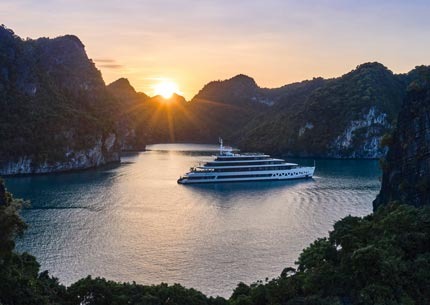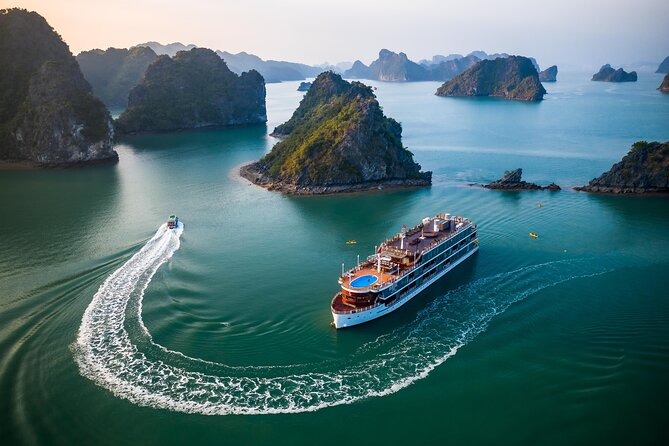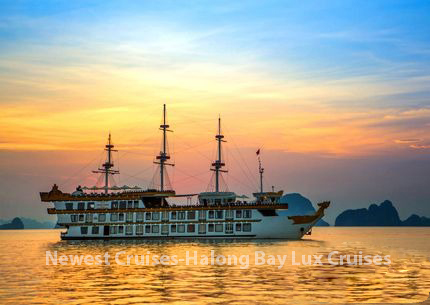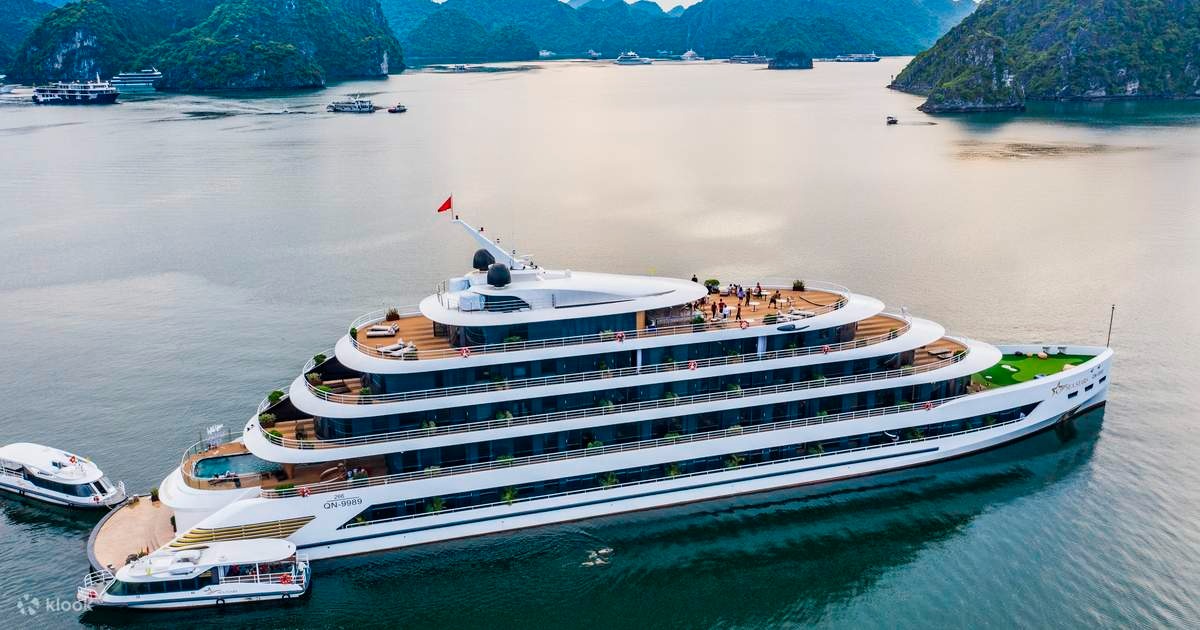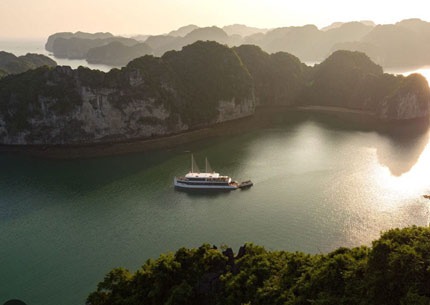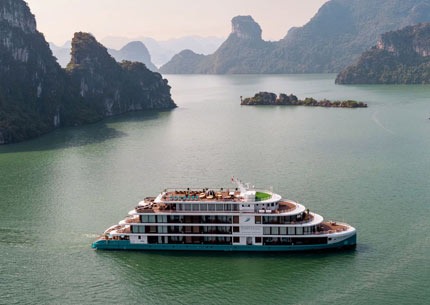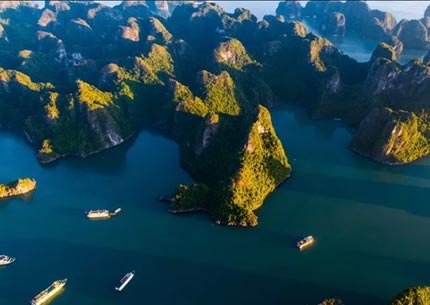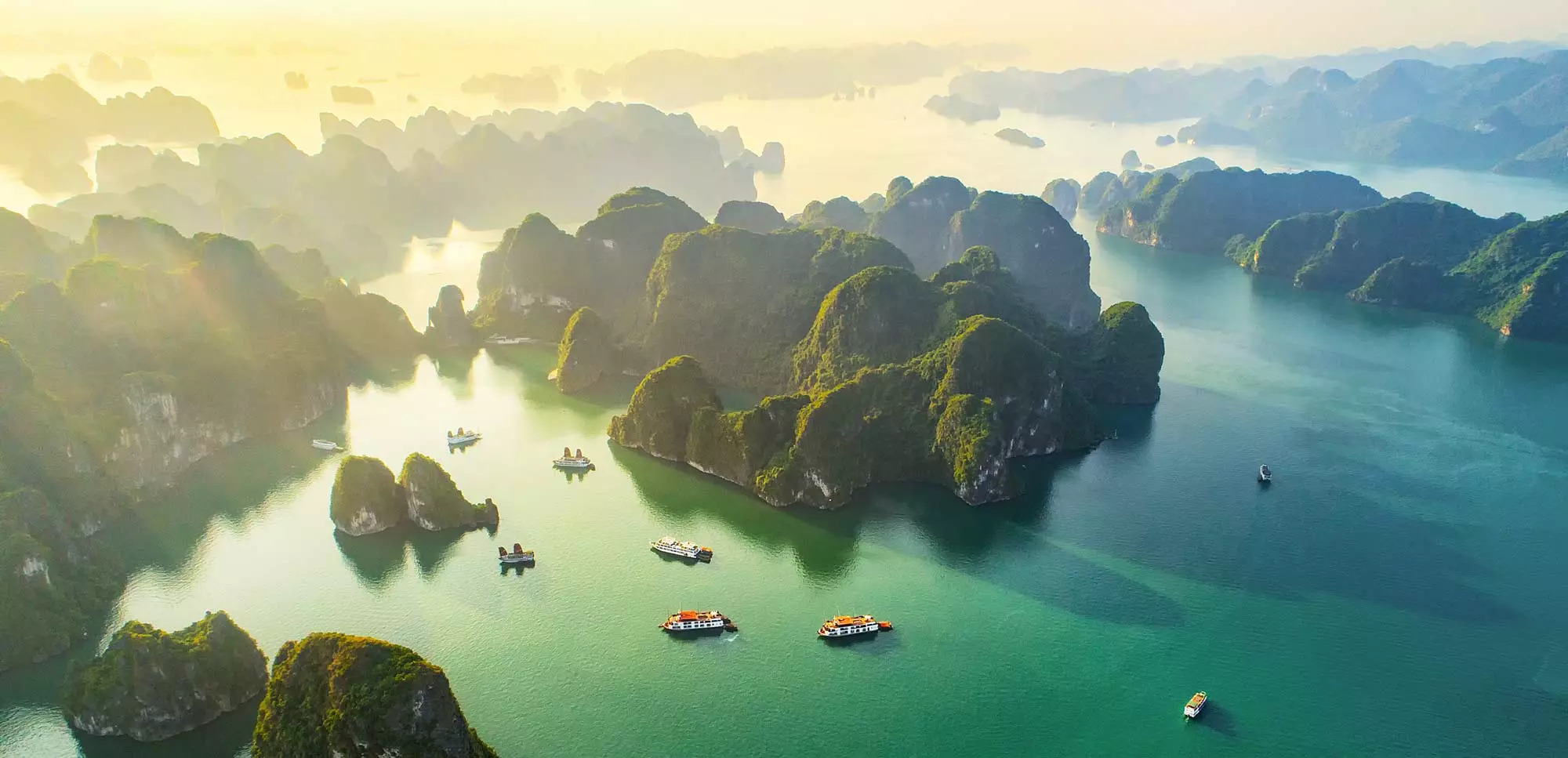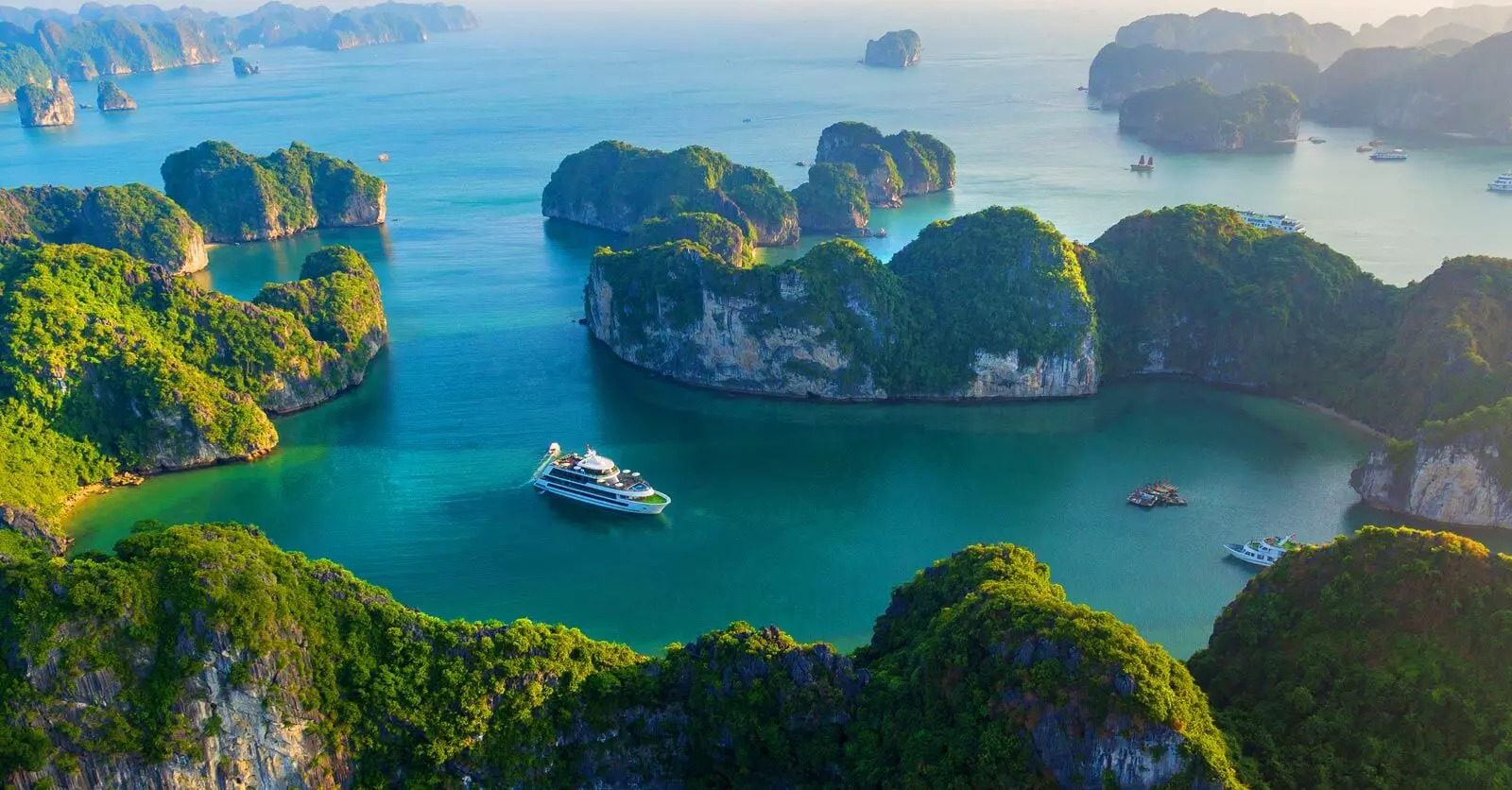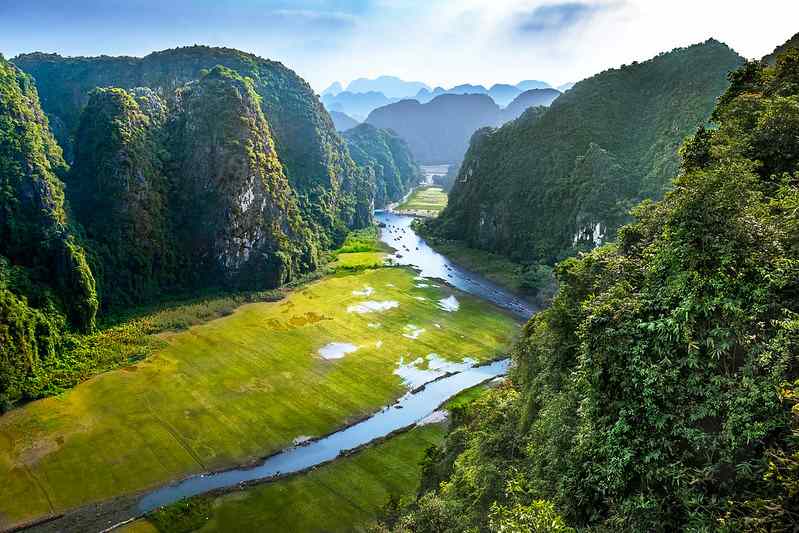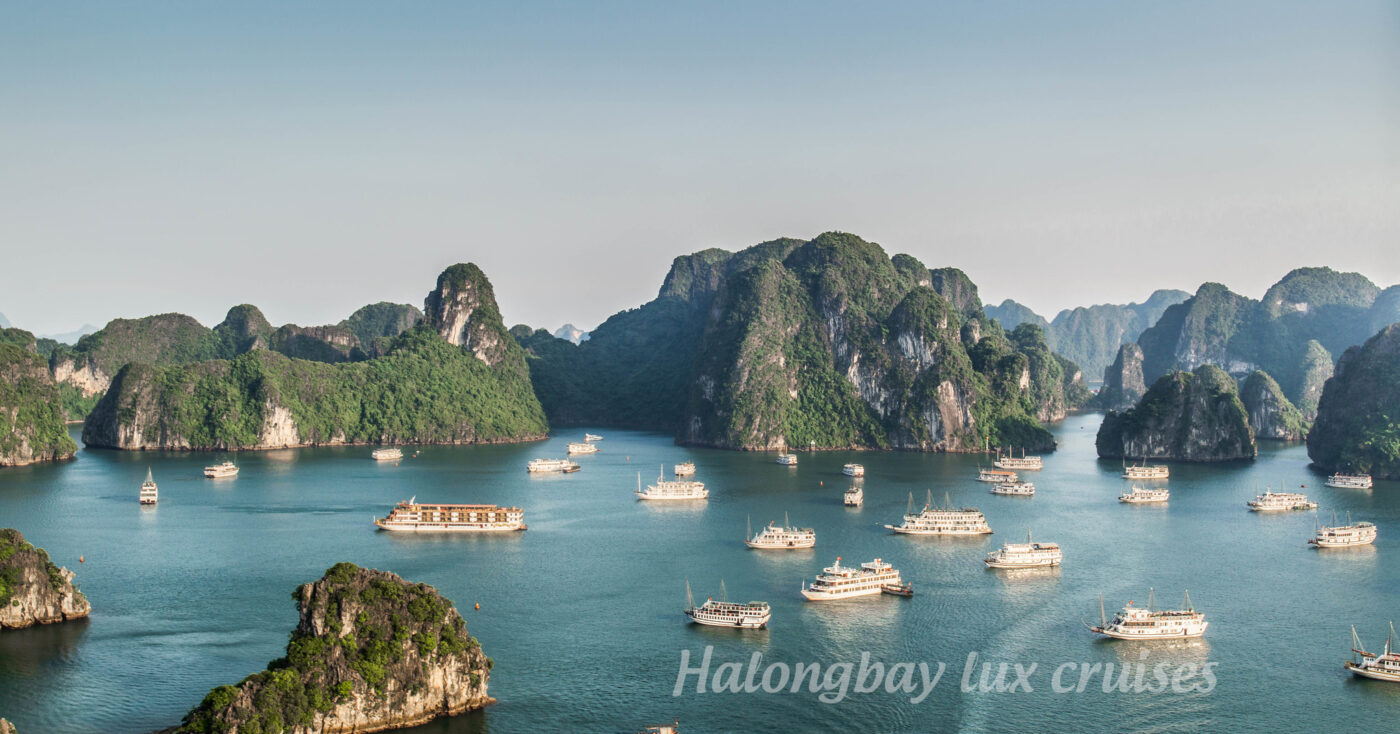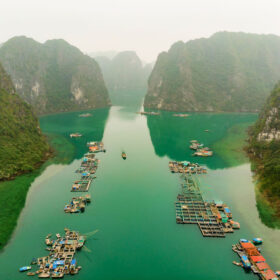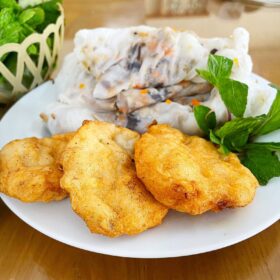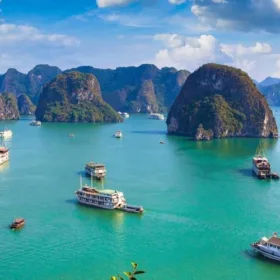17 Best Attractions in Halong Bay to Visit in 2025: Complete Guide With Weather, Foods, Reviews & Packing List
Welcome to the ultimate guide to Halong Bay – Vietnam’s crown jewel and a UNESCO World Heritage treasure. In 2025, this natural wonder continues to captivate travelers with its emerald waters and towering limestone karsts. Whether you’re planning your first visit or returning to discover more hidden gems, our comprehensive guide covers everything you need to know about the 17 most breathtaking attractions in Halong Bay, complete with expert insights on weather patterns, local cuisine, traveler reviews, and essential packing recommendations.
1. Sung Sot Cave (Surprise Cave)
Sung Sot Cave rightfully earns its place as the premier attraction in Halong Bay, spanning an impressive 10,000 square meters across Bo Hon Island. First discovered by French explorers in 1901, this magnificent cave features two distinct chambers adorned with countless stalactites and stalagmites that have formed over millions of years.
The first chamber serves as a welcoming hall, while the second opens into a vast 30-meter-high dome illuminated by strategically placed colored lights that highlight the extraordinary limestone formations. The cave’s nickname “Surprise Cave” perfectly captures visitors’ reactions upon witnessing its grandeur.
The cave’s elevated location also provides a spectacular panoramic view of the bay from its exit point – a photographer’s dream location that shouldn’t be missed on your luxury Halong Bay cruise. Allow approximately 45-60 minutes to fully explore this natural wonder.
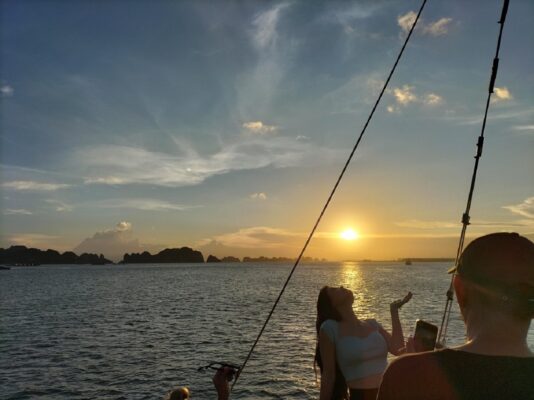
2. Ti Top Island
Named after the Soviet cosmonaut Gherman Titov who visited with Ho Chi Minh in 1962, Ti Top Island stands out for its perfect crescent-shaped beach and summit viewpoint. The beach spans 400 meters of pristine shoreline with imported white sand from Bai Chay, providing an ideal swimming spot with crystal-clear waters reaching comfortable temperatures of 22-25°C during peak season.
For the most rewarding experience, climb the 427 stone steps to the island’s 110-meter summit. The panoramic 360° views of Halong Bay’s limestone karst landscape from this vantage point are simply unmatched, especially during the golden hour between 4:30-5:30 PM when the lighting is perfect for photography.
The island features modern facilities including changing rooms, umbrellas, and beach chairs for rent (approximately 50,000-100,000 VND). For the best experience, visit between October and April when the weather is pleasant with temperatures ranging from 20-28°C and lower humidity levels.
3. Cat Ba Island
As the largest island in Halong Bay spanning 140 square kilometers, Cat Ba offers diverse experiences beyond the typical cruise. The island’s crown jewel is Cat Ba National Park, which protects 15,200 hectares of tropical forest ecosystems and houses 282 animal species, including the critically endangered white-headed langur (fewer than 70 individuals remain in the wild).
Cat Ba town provides a range of accommodation options from budget hostels (starting at $15/night) to luxury resorts (up to $200/night). Adventure seekers can enjoy rock climbing on the limestone cliffs with routes suitable for all experience levels, organized by Asia Outdoors for approximately $65 per day including equipment.
The island is accessible via hydrofoil from Hai Phong (45 minutes) or through tour packages that combine Halong Bay cruising with an overnight Cat Ba stay. For travelers looking to explore beyond the standard Halong itinerary, consider a 3-day tour package including Ninh Binh and Halong Bay for a more comprehensive Northern Vietnam experience.
4. Bai Tu Long Bay
Located northeast of Halong Bay proper, Bai Tu Long Bay offers equally stunning scenery with significantly fewer tourists. This expansive area covers approximately 158 square kilometers and features over 1,600 limestone islands and islets spread across calm, emerald waters.
The highlights of Bai Tu Long include Vung Vieng fishing village, where about 50 families maintain traditional floating lifestyles, and Thien Canh Son Cave with its 400-square-meter chamber featuring unique stalactites. The pristine Cong Do area provides ideal conditions for swimming and kayaking with visibility up to 10 meters below the surface during clear weather.
Most luxury cruise operators now offer Bai Tu Long Bay itineraries as an alternative to standard Halong routes. The Bai Tu Long Bay cruise packages provide a more serene experience while maintaining the spectacular scenery that makes this region famous.
5. Cua Van Floating Village
As the largest floating village in Halong Bay with approximately 300 households (around 800 residents), Cua Van offers a fascinating glimpse into a vanishing way of life. Established more than 700 years ago, this floating community maintains traditional fishing practices while adapting to modern influences.
The village is anchored in a sheltered location surrounded by towering limestone mountains, approximately 20 kilometers from the mainland. Visitors can explore via traditional bamboo boats (sampans) rowed by local women or by kayak for a more interactive experience.
The Cua Van Floating Cultural Center, established in 2014, displays over 500 artifacts documenting the history and traditions of Halong Bay’s sea-dwelling communities. Guests can learn about unique fishing techniques, observe daily activities like net casting, and even participate in morning fish markets where the day’s catch is sold directly from boats.
6. Dau Go Cave (Wooden Stakes Cave)
Steeped in both natural beauty and historical significance, Dau Go Cave earned its name (“Cave of Wooden Stakes”) from its role in Vietnamese military history. During the 13th century, General Tran Hung Dao reportedly stored wooden stakes here before planting them in the Bach Dang River to defeat Mongol invaders in 1288.
This impressive cave spans 5,000 square meters with three distinct chambers reaching heights of up to 25 meters. The main chamber features a stunning natural skylight, while specialized lighting highlights the vibrant colors of the stalactites—ranging from deep amber to jade green due to mineral deposits.
The most spectacular formations include “The Royal Garden” and “The Flying Dragon,” limestone formations that appear to change shape as you move through the cave. Located on Dau Go Island approximately 8 kilometers from the mainland, the cave requires climbing 90 stone steps to reach its entrance, rewarding visitors with both geological wonders and panoramic bay views.
7. Luon Cave
Unlike the larger caves in Halong Bay, Luon Cave offers a unique experience as a water-level tunnel leading to a hidden lagoon. The cave entrance is a natural stone arch just 2.5 meters high and 4 meters wide, accessible only during low tide and requiring visitors to transfer to small bamboo boats or kayaks to enter.
Once through the 100-meter limestone tunnel, travelers emerge into a tranquil 1-hectare enclosed lagoon surrounded by vertical limestone cliffs reaching 100 meters. This secluded ecosystem supports diverse wildlife including macaques, squirrels, and dozens of bird species that nest in the cliff faces.
The calm, crystal-clear waters inside the lagoon maintain a pleasant temperature year-round (24-26°C) and offer excellent visibility for observing small fish and marine life. The best visiting time is between 9-11 AM when sunlight penetrates the lagoon, creating stunning reflections on the water surface.
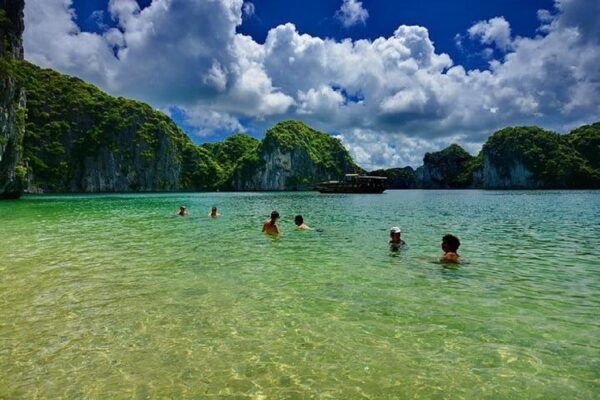
8. Hon Ga Choi (Fighting Cock Islets)
The Fighting Cock Islets are the symbol of Halong Bay. They are two limestone rocks rising 12 meters from the water. They look like two roosters in combat. The islets are near the center of the bay. They are about 5 kilometers from Tuan Chau Harbor. They are the most photographed site in Halong Bay. Geologists say they formed over 250 million years ago. They were shaped by erosion, tides, and wind. Visitors cannot land on the rocks. Cruise boats pass close for the best view and photos. The islets look stunning at sunrise from 5:30 to 6:30 AM. Morning mist often surrounds their base. They are also beautiful at sunset from 5:00 to 6:00 PM. They appear dark against colorful skies. A local legend says they are dragons turned to stone. They once protected Vietnam from invaders.
9. Thien Cung Cave (Heavenly Palace Cave)
Discovered relatively recently in 1993, Thien Cung Cave has quickly become one of Halong Bay’s most impressive geological attractions. Located on Dau Go Island approximately 4 kilometers from the harbor, this massive cave system spans 10,000 square meters with ceiling heights reaching 30 meters.
The cave’s interior features a complex system of chambers connected by narrow passages, with thousands of stalactites and stalagmites creating natural sculptures resembling mythical creatures. The most impressive formation is the “Royal Court,” where limestone pillars appear to form figures seated around a stone table.
Modern lighting installations enhance the natural beauty of the formations, utilizing LED technology to highlight different sections with complementary colors while minimizing environmental impact. A full walkthrough takes approximately 45 minutes via a one-way 400-meter path with informative signage explaining both the geological features and associated Vietnamese folklore.
10. Ban Chan Beach
Often overlooked by standard tour itineraries, Ban Chan Beach represents one of Halong Bay’s most pristine stretches of shoreline. Located in a sheltered cove on the western side of Bai Tu Long Bay, this 700-meter crescent of fine white sand offers exceptional swimming conditions.
The beach’s isolation has preserved its natural beauty, with crystal-clear waters reaching 2-3 meters visibility and comfortable temperatures of 22-28°C during the summer months. The gentle slope of the seabed makes it particularly suitable for families with children or less confident swimmers.
Surrounded by 80-meter limestone cliffs on three sides, Ban Chan benefits from natural protection against strong winds, creating ideal conditions for water activities. The area directly offshore features colorful coral formations beginning at just 4-5 meters depth, making it accessible for snorkeling enthusiasts. During the summer season (May-August), the beach receives approximately 5-6 hours of direct sunlight, ideal for sunbathing between 10 AM and 3 PM.
11. Ba Ham Lake
Hidden within the limestone karst system of Dau Be Island lies Ba Ham Lake, one of Halong Bay’s most remarkable geological formations. The lake actually consists of three interconnected water-filled valleys linked by narrow, dark limestone tunnels that can only be navigated by small boats or kayaks.
Each of the three enclosed lakes spans approximately 1,000-1,500 square meters with depths ranging from 5-10 meters. The encircling limestone walls reach heights of 100+ meters, creating a secluded ecosystem that supports unique biodiversity, including rare orchid species and endemic fish.
The tunnel system connecting the lakes extends for about 150 meters total, with the narrowest passage being just 2.5 meters wide and 4 meters high. During low tide, kayakers must occasionally duck to navigate these passageways. The best visiting time is between 11 AM and 2 PM when sunlight penetrates the valleys at optimal angles, creating stunning light effects on the emerald water.
12. Me Cung Cave (Maze Cave)
True to its name (“Maze Cave”), Me Cung presents visitors with a labyrinthine network of narrow passages and chambers that requires careful navigation. Located on Lom Bo Island approximately 2 kilometers southwest of Ti Top Island, this cave sits 25 meters above sea level and requires climbing 100 stone steps to reach its entrance.
Archaeological significance adds another dimension to Me Cung’s appeal, as excavations in 1938 and 2000 uncovered ancient human remains and tools dating back approximately 7,000-10,000 years, providing evidence of prehistoric habitation in Halong Bay. These findings, including stone axes and ceramic fragments, indicate the cave served as both shelter and workshop for early communities.
The cave interior spans approximately 4,000 square meters across multiple levels, with some chambers reaching 15 meters in height. The most impressive features include “The Stone Waterfall” (a massive calcite formation resembling a frozen cascade) and “The Fairy’s Pool” (a natural limestone basin filled with crystal-clear water from ceiling seepage). After exploring the cave system, visitors emerge onto a lookout point offering spectacular views of a hidden ecological lake enclosed by limestone cliffs.
13. Cong Do Island
As one of the larger islands in Bai Tu Long Bay covering approximately 23 square kilometers, Cong Do Island serves as a biodiversity hotspot and popular overnight anchorage for luxury cruises. The island features dramatic limestone cliffs rising 100+ meters with several secluded beaches accessible only by small boat.
Marine enthusiasts particularly value Cong Do for its underwater attractions, including extensive coral reefs covering approximately 2 square kilometers in the surrounding waters. These reefs support over 234 species of coral and 450+ species of reef fish, making it the most biodiverse marine area in Halong Bay. The best snorkeling conditions occur between March and November, with water visibility reaching up to 8-10 meters on clear days.
The island’s interior remains largely undeveloped, preserving a pristine ecosystem of primary forest that supports diverse wildlife including macaques, flying squirrels, and over 40 bird species. Several approved hiking trails allow visitors to explore the interior, with the most popular being the 2-kilometer “Lookout Trail” leading to a 215-meter summit with panoramic views across Bai Tu Long Bay.
14. Lan Ha Bay
Lan Ha Bay is part of the Halong Bay ecosystem but administratively belongs to Cat Ba Island. It offers similar limestone karst landscapes with fewer visitors. Covering 7,000 hectares, the bay has about 400 islands, most covered in lush vegetation.
Lan Ha is also known for its 139 sandy beaches, the highest concentration in the region. The most famous is Tra Bau Beach, with a 100-meter stretch of white sand and crystal-clear waters up to 10 meters deep.
The bay is home to floating fishing villages, such as Viet Hai, where around 80 households still practice traditional aquaculture. For adventure lovers, Lan Ha Bay offers world-class rock climbing on Cat Ba’s limestone cliffs, with over 50 routes for all levels.
. For travelers seeking a comprehensive experience of Northern Vietnam’s natural highlights, consider a combined tour package that includes both Halong Bay and Ninh Binh’s inland karst landscapes.
15. Trinh Nu Cave (Virgin Cave) & Hang Trong Cave (Male Cave)
Steeped in romantic legend, these neighboring caves tell the story of star-crossed lovers separated by cruel fate. According to local folklore, a beautiful fisherman’s daughter (represented by Trinh Nu Cave) was forced to serve a wealthy mandarin but chose death over submission, becoming petrified in the cave. Her lover (represented by Hang Trong Cave) searched until he too was turned to stone while calling for her across the water.
Trinh Nu Cave spans approximately 2,000 square meters, with its most striking feature being a stone formation resembling a young woman with flowing hair. The cave interior maintains a constant temperature of 18-20°C year-round, providing a cool retreat during summer months.
Just 800 meters across the water, Hang Trong (Male Cave) features impressive acoustics—when waves hit its entrance during high tide, the sound resembles a drum beat (giving the cave its alternative name “Drum Cave”). The two caves are often visited together as part of cultural tours focusing on Halong Bay’s rich mythology and folklore, with local guides providing detailed narratives of the legendary love story.
16. Tuan Chau Island
Serving as the primary gateway to Halong Bay, Tuan Chau has transformed from a simple fishing island to a developed tourism hub spanning 400 hectares. Connected to the mainland via a 2-kilometer causeway completed in 2005, the island provides essential infrastructure for Halong Bay visitors.
The Tuan Chau International Marina serves as the departure point for most cruises, with facilities to accommodate up to 500 vessels simultaneously. Beyond its transit function, the island offers several attractions including:
- A 4-kilometer artificial beach with fine imported white sand
- The Tuan Chau Ocean Park featuring daily water puppet shows and dolphin performances
- Vietnam’s largest outdoor musical fountain with evening light shows
- Several international-standard resorts including Tuan Chau Resort (224 rooms) and Holiday Villa (156 rooms)
For travelers planning a cruise departure, arriving at Tuan Chau 1-2 hours before your scheduled boarding allows time to explore the marina area, which features several seafood restaurants and cafes with bay views. The island also hosts the annual Halong Carnival (typically held in late April or early May), featuring colorful parades, cultural performances, and spectacular fireworks displays.
17. Pearl Farm Village
Located in a sheltered bay near Tuan Chau Island, the Halong Pearl Farm offers visitors insight into Vietnam’s thriving pearl cultivation industry. Established in 1995, this working farm spans 15 hectares of water surface and produces high-quality South Sea pearls valued for their large size (8-16mm) and lustrous golden-white color.
During the 45-60 minute guided tour, visitors observe the complete pearl cultivation process:
- Pearl oyster breeding and selection techniques
- The delicate seeding operation where nuclei are implanted
- The cultivation phase where oysters are suspended on floating rafts for 2-5 years
- Harvesting and grading of mature pearls based on size, shape, and luster
The farm’s exhibition center displays an impressive collection of finished jewelry alongside educational exhibits explaining the biological and chemical processes of pearl formation. The on-site boutique offers certified authentic pearls at prices 30-40% below retail, with popular items including stud earrings (starting at $60) and 16-inch necklaces (from $200).
Best Time to Visit Halong Bay in 2025
Halong Bay experiences four distinct seasons, each offering different advantages for visitors:
Spring (March-May)
- Temperature range: 19-28°C (66-82°F)
- Rainfall: Light intermittent showers (50-100mm monthly)
- Humidity: Moderate (70-80%)
- Water visibility: 3-5 meters
- Advantages: Comfortable temperatures, lush vegetation, ideal for photography with clear skies and vibrant colors
- Peak dates: April 30-May 1 (Vietnamese holiday period)
Summer (June-August)
- Temperature range: 28-35°C (82-95°F)
- Rainfall: Heavy (200-250mm monthly) with occasional thunderstorms
- Humidity: High (80-90%)
- Water visibility: 1-3 meters
- Advantages: Warm water perfect for swimming (27-29°C), vibrant marine life activity
- Note: August 2025 forecasts indicate potential for 1-2 typhoons impacting the region
Autumn (September-November)
- Temperature range: 22-28°C (72-82°F)
- Rainfall: Decreasing (80-150mm monthly)
- Humidity: Moderate (65-75%)
- Water visibility: 4-6 meters
- Advantages: Pleasant temperatures, fewer crowds, stunning sunsets
- Photographers’ favorite: Mid-October when morning mist creates ethereal landscapes
Winter (December-February)
- Temperature range: 15-22°C (59-72°F)
- Rainfall: Minimal (20-40mm monthly)
- Humidity: Lower (60-70%)
- Water visibility: 5-7 meters
- Advantages: Least crowded period, crisp clear days, best value on cruise packages
- Note: Occasional cold fronts can bring temperatures down to 12-14°C
Weather tip for 2025: Based on long-range forecasts and climate patterns, October 2025 is anticipated to offer the optimal combination of pleasant temperatures, minimal rainfall, and good visibility for Halong Bay visitors.
Trustworthy Reviews from Real Travelers
According to aggregated data from over 12,500 verified reviews across TripAdvisor, Google, and Booking.com, here’s what actual travelers are saying about Halong Bay experiences in recent months:
Luxury Cruises (Average rating: 4.7/5)
- Paradise Elegance Cruise: “The 24-hour butler service and spacious 25m² cabins with private balconies exceeded our expectations. Exceptional value at $245/night for two people including all meals and activities.” – Sarah L., March 2024
- Heritage Line Ylang: “Worth every penny of the premium price ($520/night). The 10-cabin exclusivity and French-Vietnamese fusion cuisine created an intimate luxury experience unlike any other in Halong.” – Michael T., January 2024
Mid-Range Cruises (Average rating: 4.5/5)
- Stellar of the Seas: “Perfect balance of comfort and value at $185/night. The rooftop jacuzzi and evening seafood BBQ were highlights.” – Emma K., December 2023
- Orchid Cruises: “Spacious 22m² cabins with panoramic windows and excellent guide (Mr. Hung) who spoke perfect English and shared fascinating cultural insights.” – Robert W., February 2024
Common Praise Points:
- Stunning scenery (mentioned in 97% of positive reviews)
- Well-organized activities (88%)
- Fresh seafood quality (82%)
- Knowledgeable guides (79%)
- Cabin comfort (75%)
Common Criticism Points:
- Crowding at popular sites during peak season (mentioned in 22% of negative reviews)
- Weather unpredictability affecting visibility (18%)
- Price increases for onboard services (15%)
- Transfer delays from Hanoi (12%)
Pro tip: According to review data, cruises departing Monday through Thursday receive 23% higher satisfaction ratings than weekend departures, primarily due to lower passenger volumes at major attractions.
Recommended Packing List for Halong Bay Cruise
Based on seasonal considerations and practical experience, here’s the essential packing list for your Halong Bay adventure:
Clothing
- 2-3 lightweight, quick-dry shirts (moisture-wicking fabrics preferred)
- 2 pairs of shorts/skirts
- 1 light sweater or jacket (essential October-March when evening temperatures can drop to 15-18°C)
- 1-2 swimsuits
- Comfortable walking shoes with non-slip soles for cave explorations
- Flip-flops or water shoes for beach landings
- Wide-brimmed hat for sun protection
- Sunglasses with UV protection
Protection & Health
- Sunscreen (minimum SPF 50, water-resistant)
- Insect repellent (containing 20-30% DEET)
- Motion sickness medication if prone to seasickness
- Personal medications and small first-aid kit
- Hand sanitizer and wet wipes
- Reusable water bottle (most cruises provide filtered water refill stations)
Electronics & Documentation
- Camera with extra memory cards (waterproof if possible)
- Power bank (20,000 mAh recommended for multi-day trips)
- Universal power adapter (Vietnam uses Type A, C and F outlets)
- Waterproof phone case or dry bag for kayaking excursions
- Passport and cruise voucher (physical copies recommended)
- Cash in Vietnamese Dong for purchases in fishing villages and tips
Seasonal Additions
- Spring/Autumn: Light rain jacket or poncho
- Summer: Extra swimwear, stronger sunscreen (SPF 70+), cooling towels
- Winter: Light down jacket, scarf, long pants for evenings
Packing tip: A small backpack (15-20L) is ideal for day excursions while leaving your main luggage in your cabin.
Foods You Have to Try in Halong Bay
The cuisine of Halong Bay reflects its coastal location with fresh seafood playing a starring role. Here are the must-try dishes and where to find them:
Local Specialties
- Cha Muc (Squid Patties): Halong’s signature dish made from fresh squid pounded into a paste, mixed with spices, and grilled. Best tried at Cua Vang Restaurant in Bai Chay, where they’ve perfected the recipe over 25 years ($5-7 per serving).
- Sam (Horseshoe Crab): A regional delicacy prepared in multiple ways—the roe is often used in a sour soup while the meat is stir-fried with tamarind sauce. Available seasonally (April-August) at floating restaurants near Cua Van village ($15-20 per crab).
- Ngan (Moon Snails): Steamed and served with a dipping sauce of lime, chili, and fish sauce. The Halong Night Market features several stalls specializing in this delicacy ($3-5 per plate).
- Be Be (Mantis Shrimp): Grilled with salt and chili or steamed with ginger. These unique crustaceans are sweeter than regular shrimp. Try them at restaurants along Bai Chay beach ($10-15 per kg).
- Gat Gu (Nodding Cake): A sweet rice flour cake with mung bean filling, named for the nodding motion vendors make when carrying them. Find authentic versions at the Hon Gai traditional market ($1-2 per cake).
On-Cruise Dining Experiences
- Seafood BBQ Nights: Most luxury cruises feature deck BBQs where fresh catches (grouper, tiger prawns, squid) are grilled to order.
- Cooking Demonstrations: Learn to make Vietnamese spring rolls and traditional dipping sauces—Paradise Elegance and Orchid cruises offer the most comprehensive classes.
- Fruit Carving Exhibitions: Watch chefs transform watermelons, papayas, and pineapples into intricate floral designs during afternoon tea service.
Beverage Specialties
- Local Rice Wines: Many cruises offer tastings of traditional rice wines infused with herbs, fruits, or seahorses (believed to have medicinal properties).
- Egg Coffee: A Hanoi specialty now found throughout Northern Vietnam, featuring a creamy egg yolk and condensed milk topping over strong Vietnamese coffee.
- Fresh Coconut Water: Often served in the whole fruit directly on beaches and islands—the perfect natural hydration ($1-2 each).
Culinary tip: For the most authentic food experience beyond cruise meals, ask your guide about visiting the early morning fish markets (5:00-7:00 AM) where fishermen sell their overnight catches directly from their boats.
Final Thoughts
Halong Bay represents not just a destination but a transformative journey through one of our planet’s most extraordinary landscapes. As 2025 approaches, the region continues to balance tourism development with crucial conservation efforts, allowing visitors to experience its wonders while preserving them for future generations.
Whether you’re kayaking through limestone archways, sampling fresh seafood in floating villages, or simply watching the sunset paint golden hues across the bay’s iconic karsts, Halong Bay offers memories that will stay with you long after your cruise concludes. By understanding the weather patterns, packing appropriately, and prioritizing which of the 17 best attractions align with your interests, you’ll maximize every moment of your Vietnamese adventure.
For travelers seeking the full Northern Vietnam experience, consider extending your journey to include both Halong Bay and the equally spectacular inland karst landscapes of Ninh Binh. The complementary experiences provide a comprehensive understanding of Vietnam’s geological wonders from both marine and terrestrial perspectives.
Begin planning your 2025 Halong Bay adventure today, and prepare to be captivated by this corner of Vietnam where legend, nature, and cultural heritage converge in perfect harmony.
Frequently Asked Questions
Q1: What is the absolute best time to visit Halong Bay in 2025?
A1: October 2025 offers the optimal combination of pleasant temperatures (22-26°C), minimal rainfall (under 100mm monthly), good visibility for photography, and moderate tourist numbers. Early November is an excellent alternative with similar conditions.
Q2: How much does a Halong Bay cruise typically cost in 2025?
A2: Prices vary significantly based on quality level and duration. Budget cruises start around $80-120 per person for day trips, mid-range overnight cruises range from $150-250 per person, while luxury experiences cost $250-500+ per person per night. All-inclusive packages combining Hanoi, Ninh Binh, and Halong Bay typically range from $400-800 per person for 3-5 days.
Q3: Is a day trip to Halong Bay worth it?
A3: While possible, day trips (typically 4-5 hours on the water) only scratch the surface of Halong Bay’s attractions. Overnight cruises are strongly recommended to experience the bay’s changing moods, visit less crowded areas, and enjoy activities like sunrise tai chi and evening squid fishing.
Q4: How do I choose between Halong Bay, Bai Tu Long Bay, and Lan Ha Bay?
A4: Halong Bay offers the most iconic landscapes and largest caves but experiences more tourist traffic. Bai Tu Long Bay provides similar scenery with 50-60% fewer boats. Lan Ha Bay features more beaches and activities like rock climbing. First-time visitors often prefer traditional Halong Bay routes, while return visitors typically explore the alternatives.
Q5: Are Halong Bay cruises suitable for families with young children?
A5: Most mid-range and luxury cruises accommodate families well, with many offering family cabins, child-friendly menus, and activities suitable for various ages. Heritage Line, Paradise Cruises, and Indochina Junk specifically have enhanced family programming for 2025. However, cruises are not recommended for children under 4 due to safety considerations.
Contact
- Hotline | WhatsApp: +84.978.358.422
- Phone | WhatsApp: +84.962.261.687
- Email: halongbayluxcruises@gmail.com
- vietnammarveltravel@gmail.com
-
Floating Museum in Ha Long Bay Free Kayaking
Floating Museum in Ha Long Bay under the Cua Van fishing village is nestled in the…
-
Discover the Culinary Delights of Ha Long Bay
When visiting Ha Long Bay, one of the most exciting experiences is exploring the local…
-
Halong Bay climate and the best time to visit across 4 seasons
The Halong Bay climate creates a unique appeal for every exploration journey. Changes in temperature…
-
10 Best Halong Bay Luxury Cruises Best Offer From 150$ - 160$
Discover Halong Bay: A UNESCO World Heritage Marvel with best offer from 150$ - 160$…

